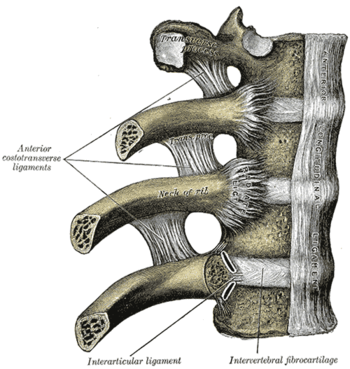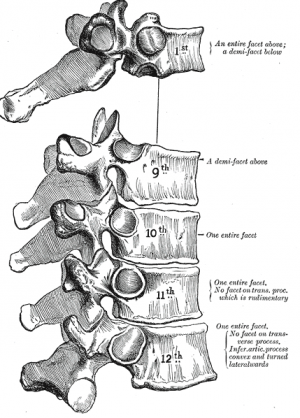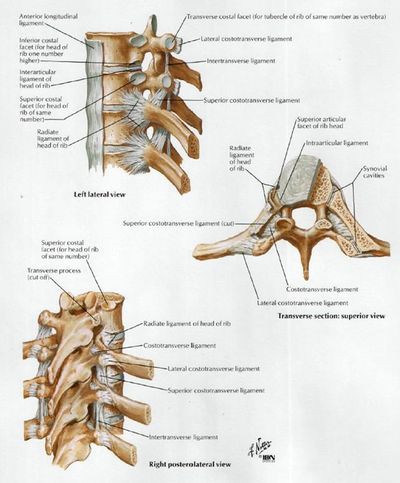Costovertebral Joints: Difference between revisions
(category) |
Kim Jackson (talk | contribs) No edit summary |
||
| (9 intermediate revisions by 2 users not shown) | |||
| Line 6: | Line 6: | ||
</div> | </div> | ||
==Introduction== | |||
The costovertebral joints describe two groups of synovial plane joints which connect the proximal end of the [[ribs]] with their corresponding [[Thoracic Vertebrae|thoracic vertebrae]], enclosing the thoracic cage from the posterior side.[[File:Gray312.png|Costovertebral articulations. Anterior view.|right|frameless|369x369px]] | |||
Joining of ribs to the vertebrae occurs at two places | |||
# Head - Two convex facets from the head attach to two adjacent vertebrae. This forms a [[Joint Classification|synovial planar (gliding) joint]], which is strengthened by the ligament of the head and the intercapital ligament. | |||
# Tubercle of the rib - Articulation of the tubercle is to the transverse process of the adjacent vertebrae. This articulation is reinforced by the dorsal costotransverse ligament<ref>Gray.H,Gray's anatomy 20th edition,page 299</ref> | |||
==Anatomy == | |||
There are two types of | === Costovertebral Joint === | ||
Costovertebral joint consists of the head of the rib (the head of a typical rib has two facets - each facet with a separate synovial joint separated by a ridge. The head of each rib articulates with: | |||
* The lower rib facet articulates with the upper costal facet of its own vertebra | |||
* The upper facet articulates with the lower facet of the vertebral body above. | |||
* The first rib articulates with the T1 vertebra only and the lowest three ribs articulate only with their own vertebral body. | |||
There are two types of [[Ligament|ligaments]]: | |||
# intra-articular ligament - attaches the intervertebral disc to the ridge in between the two facets of the head of the rib. | |||
# radiate ligament - formed by three bands which connect the rib head to the vertebral bodies. A superior band runs to the vertebral body above and an inferior band runs to the vertebral body below. A central band runs deep to the anterior longitudinal ligament and blends into the intervertebral disc to join the ligament on the opposite side. In the first rib and the last three ribs, only two bands exist as they only articulate with their own vertebra<ref name=":1">Radiopedia [https://radiopaedia.org/articles/costovertebral-joint Costrovert. Joint] Available from:https://radiopaedia.org/articles/costovertebral-joint (last accessed 10.5.2020)</ref>. | |||
[[File:Afbeelding 3.png|right|frameless]] | |||
* | === Costotransverse Joint === | ||
There are two facets of a tubercle of a rib, the medial and lateral. | |||
# The hyaline cartilage-lined medial facet forms a plane synovial joint with the tip of the transverse process which is reinforced by a capsule. | |||
# The lateral facet is attached to the transverse process through three ligaments: | |||
* Lateral costotransverse ligament - attaches the lateral facet to the tip of the transverse process of the vertebral body. | |||
* Costotransverse ligament - attaches the back of the neck of the rib to the front of the transverse process | |||
* Superior costotransverse ligaments - attaches the neck of the rib to the underside of the transverse process of the vertebra above | |||
The lower two ribs are only attached by ligaments and do not form synovial joints with the transverse process<ref name=":1" />. | |||
===Movements=== | |||
The movements on these joints are called ‘pump-handle’ or ‘bucket-handle’ movements, and are limited to a small degree of gliding and rotation of the rib head. | |||
* | * The function of these movements is to enable lifting of the ribs upwards and outwards during breathing. | ||
* The end result is the increase of the lateral diameter of the thorax and subsequent expansion of the lung parenchyma as the air is being inhaled<ref name=":0">Kenhub [https://www.kenhub.com/en/library/anatomy/costovertebral-joints CV joints] Available from:https://www.kenhub.com/en/library/anatomy/costovertebral-joints (last accessed 10.5.2020)</ref>. | |||
The costovertebral complex is an essential component of the biomechanics of chest wall movement. The costovertebral ligaments make the actions of the costovertebral joints and intervertebral movement possible. The ligaments function to: | |||
* Affix, stabilize and allow some motion of the ribs on the thoracic vertebra at the costovertebral joint. Their presence helps with the load-bearing, protection, posture and scaffolding roles that the thoracic cage provides with their stabilization properties . | |||
* Allow and limit movement of the ribs at the transverse joint to allow for maximum expansion of the thoracic cavity as needed for respiratory demand. Their actions on both the costovertebral and intervertebral complexes allow lateral bending and axial rotation. | |||
=== | === Muscles That Act on the Costovertebral Joints === | ||
The | [[File:Image017.jpg|right|frameless|483x483px]] | ||
The prime movers of the costovertebral joints are the muscles of respiration.ie | |||
* [[Muscles of Respiration|Respiratory diaphragm]] | |||
* [[Muscles of Respiration|Intercostal muscles.]] | |||
However, all the muscles that attach to the ribs and which are sorted as accessory respiratory muscles can cause the movements on these joints; | |||
[[sternocleidomastoid]], [[scalene]], [[Serratus Anterior|serratus anterior]], [[pectoralis major]], [[Pectoralis Minor|pectoralis minor]], [[Latissimus Dorsi Muscle|latissimus dorsi]] and [[Serratus Posterior|serratus posterior]] superior. | |||
* | ===Innervation of the Costovertebral Ligaments === | ||
Both types of costovertebral joints are innervated by the lateral branches of the posterior rami of spinal nerves C8-T11. | |||
* The innervation has a segmental pattern | |||
* Each joint receives the fibers from a spinal nerve of its numerically equivalent level and from the level above.<ref name=":0" /> | |||
==Clinical Significance== | |||
Costotransverse disorders are disorders affecting or involving the costotransverse and costovertebral joints and ligaments. Important considerations: | |||
* Often overlooked yet it can be responsible for pain in the thoracic region or functional impairments of the thoracic spine. | |||
* May occur due to trauma, degenerative changes, tumours, deformities or muscular spasm. | |||
* A diagnosis is usually made through a clinical examination with treatment consisting of mobilisation, exercise therapy, injections and/or fixation of unstable joints<ref>B A Young, H E Gill, R S Wainner, T W Flynn. Thoracic costotransverse joint pain patterns: a study in normal volunteers. BMC Musculoskelet disord. 2008; 9: 140 </ref>. | |||
== | |||
* | |||
* | |||
</ref> | |||
==References== | ==References== | ||
Latest revision as of 13:30, 9 April 2024
Original Editor - Rewan Aloush
Top Contributors - Rewan Aloush, Lucinda hampton, Kim Jackson and George Prudden
Introduction[edit | edit source]
The costovertebral joints describe two groups of synovial plane joints which connect the proximal end of the ribs with their corresponding thoracic vertebrae, enclosing the thoracic cage from the posterior side.
Joining of ribs to the vertebrae occurs at two places
- Head - Two convex facets from the head attach to two adjacent vertebrae. This forms a synovial planar (gliding) joint, which is strengthened by the ligament of the head and the intercapital ligament.
- Tubercle of the rib - Articulation of the tubercle is to the transverse process of the adjacent vertebrae. This articulation is reinforced by the dorsal costotransverse ligament[1]
Anatomy[edit | edit source]
Costovertebral Joint[edit | edit source]
Costovertebral joint consists of the head of the rib (the head of a typical rib has two facets - each facet with a separate synovial joint separated by a ridge. The head of each rib articulates with:
- The lower rib facet articulates with the upper costal facet of its own vertebra
- The upper facet articulates with the lower facet of the vertebral body above.
- The first rib articulates with the T1 vertebra only and the lowest three ribs articulate only with their own vertebral body.
There are two types of ligaments:
- intra-articular ligament - attaches the intervertebral disc to the ridge in between the two facets of the head of the rib.
- radiate ligament - formed by three bands which connect the rib head to the vertebral bodies. A superior band runs to the vertebral body above and an inferior band runs to the vertebral body below. A central band runs deep to the anterior longitudinal ligament and blends into the intervertebral disc to join the ligament on the opposite side. In the first rib and the last three ribs, only two bands exist as they only articulate with their own vertebra[2].
Costotransverse Joint[edit | edit source]
There are two facets of a tubercle of a rib, the medial and lateral.
- The hyaline cartilage-lined medial facet forms a plane synovial joint with the tip of the transverse process which is reinforced by a capsule.
- The lateral facet is attached to the transverse process through three ligaments:
- Lateral costotransverse ligament - attaches the lateral facet to the tip of the transverse process of the vertebral body.
- Costotransverse ligament - attaches the back of the neck of the rib to the front of the transverse process
- Superior costotransverse ligaments - attaches the neck of the rib to the underside of the transverse process of the vertebra above
The lower two ribs are only attached by ligaments and do not form synovial joints with the transverse process[2].
Movements[edit | edit source]
The movements on these joints are called ‘pump-handle’ or ‘bucket-handle’ movements, and are limited to a small degree of gliding and rotation of the rib head.
- The function of these movements is to enable lifting of the ribs upwards and outwards during breathing.
- The end result is the increase of the lateral diameter of the thorax and subsequent expansion of the lung parenchyma as the air is being inhaled[3].
The costovertebral complex is an essential component of the biomechanics of chest wall movement. The costovertebral ligaments make the actions of the costovertebral joints and intervertebral movement possible. The ligaments function to:
- Affix, stabilize and allow some motion of the ribs on the thoracic vertebra at the costovertebral joint. Their presence helps with the load-bearing, protection, posture and scaffolding roles that the thoracic cage provides with their stabilization properties .
- Allow and limit movement of the ribs at the transverse joint to allow for maximum expansion of the thoracic cavity as needed for respiratory demand. Their actions on both the costovertebral and intervertebral complexes allow lateral bending and axial rotation.
Muscles That Act on the Costovertebral Joints[edit | edit source]
The prime movers of the costovertebral joints are the muscles of respiration.ie
However, all the muscles that attach to the ribs and which are sorted as accessory respiratory muscles can cause the movements on these joints;
sternocleidomastoid, scalene, serratus anterior, pectoralis major, pectoralis minor, latissimus dorsi and serratus posterior superior.
Innervation of the Costovertebral Ligaments[edit | edit source]
Both types of costovertebral joints are innervated by the lateral branches of the posterior rami of spinal nerves C8-T11.
- The innervation has a segmental pattern
- Each joint receives the fibers from a spinal nerve of its numerically equivalent level and from the level above.[3]
Clinical Significance[edit | edit source]
Costotransverse disorders are disorders affecting or involving the costotransverse and costovertebral joints and ligaments. Important considerations:
- Often overlooked yet it can be responsible for pain in the thoracic region or functional impairments of the thoracic spine.
- May occur due to trauma, degenerative changes, tumours, deformities or muscular spasm.
- A diagnosis is usually made through a clinical examination with treatment consisting of mobilisation, exercise therapy, injections and/or fixation of unstable joints[4].
References[edit | edit source]
- ↑ Gray.H,Gray's anatomy 20th edition,page 299
- ↑ 2.0 2.1 Radiopedia Costrovert. Joint Available from:https://radiopaedia.org/articles/costovertebral-joint (last accessed 10.5.2020)
- ↑ 3.0 3.1 Kenhub CV joints Available from:https://www.kenhub.com/en/library/anatomy/costovertebral-joints (last accessed 10.5.2020)
- ↑ B A Young, H E Gill, R S Wainner, T W Flynn. Thoracic costotransverse joint pain patterns: a study in normal volunteers. BMC Musculoskelet disord. 2008; 9: 140









